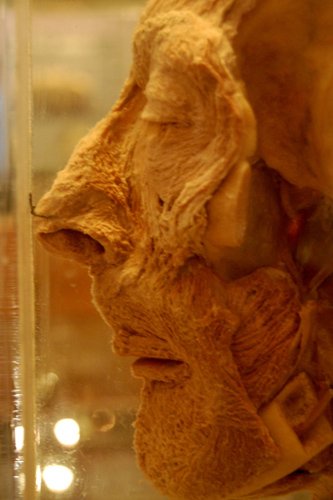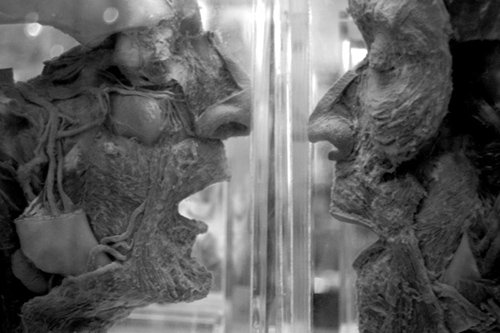
Photographs from the anatomical collection of
Museum Bleulandinum
Anatomisch Museum, Functionele Anatomie,
Universiteit Utrecht
February 2008
No. 249
Museum Bleulandinum is organized around the collection of Jan Bleuland (1756-1838), a medical doctor and professor of anatomy and obstetrics at Utrecht University. Prof. Dr. Bleuland was well known for the high quality of his anatomical models, which he prepared himself using highly innovative techniques. Among Bleuland's greatest achievements were preparations displaying vascular systems, in which he made even the tiniest blood vessels visible by injecting concoctions of dye or mercury. Another of Bleuland's specialties was in finding methods which accurately preserved the true colors and textures of organs, which in less careful hands might become bleached and shrunken.
In addition to creating his own preparations, Bleuland actively acquired examples of earlier masters, most notably specimens crafted by Amsterdam anatomist Frederik Ruysch (1638-1731), whose elaborate and often allegorical presentations disguised the voorsnijder's cuts with items of jewelry and clothing. One fine example to be found on display in the museum is Ruysch's “Kinderhoofdje met Turkse muts” (Child's head with Turkish cap).
In 1815, Willem I of the Netherlands (1772-1843) purchased Bleuland's collection and donated it to Utrecht University, which took ownership upon Bleuland's death in 1838. Clearly enthusiastic about the benefit this collection would have in the education of future doctors, Willem issued a royal decree the following year that all Dutch universities install such cabinets, which was surely a boon to education in general and anatomists like Bleuland in particular.
Today, the Museum Bleulandinum includes the original 475 objects purchased from Bleuland (Collectie Bleuland), anatomical waxes by Petrus Koning (1787-1834), a library of important historical medical texts, and several other anatomy and embryology collections — including examples of modern plastination. The museum now resides within Utrecht's Universitair Medisch Centrum.
Special thanks to Peter Heller, who allowed me access to the collection and spent a great deal of time talking about Bleuland's methods and introducing me to his favorite specimens; Reina de Raat, who gave me a wonderful ‘behind the scenes’ tour of the Universiteitsmuseum storage depot; Willem Mulder, for generously acting as my Utrecht tour guide and imparting some of his expansive knowledge in this field; and Rosamond Purcell for her advice and introductions.
Profile





Duet



Orang-utan foetus

Argument



No. 22 Sympodie


No. 336 (dentes deciduales)

No. 304





Reaching


Sirenomelia



Kinderhoofdje met Turkse muts
